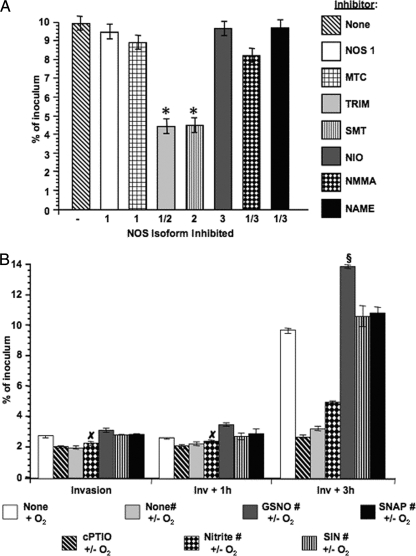FIG. 9.
NOS2-derived NO promotes the intracellular survival of gonococci within pex cells. (A) Pex cells were treated with a panel of NOS inhibitors. (B) Alternatively, the NO scavenger cPTIO; nitrite; or the NO donors GSNO, SIN, or SNAP were included in the assay, as indicated. Pex cell monolayers were challenged with wild-type bacteria for 90 min, followed by a 30-min gentamicin treatment to kill extracellular bacteria. Invasion and survival assays were performed as described in the text where invasion refers to a 90-min infection plus gentamicin treatment. Survival refers to the number of viable gonococci that were recovered from within pex cells at 1 h (Inv + 1 h) or 3 h (Inv + 3 h) after invasion. Values given are the mean (variance) in which the percent invasion or survival of gonococci was determined as a function of the original inoculum and the number of CFU formed with subsequent plating of the cervical epithelial cell lysates. The data were obtained from at least three trials performed in triplicate. For the “−” column (in panel A), a NOS inhibitor was not included in the assay. Panel A P values: *, P ≤ 0.01 for data obtained in the presence of the indicated NOS inhibitor compared to the absence of any NOS inhibitor. Panel B P values: §, P ≤ 0.01 for data obtained in the presence of GSNO compared to the absence of GSNO or the use of an alternative NO donor; ×, data obtained in the presence of nitrite were not significant compared to the absence of nitrite (i.e., none# +/− O2). The “#” symbol indicates that NO production by pex cells was inhibited by the inclusion of NAME (NOS1/3 inhibitor) and TRIM (NOS1/2 inhibitor).

